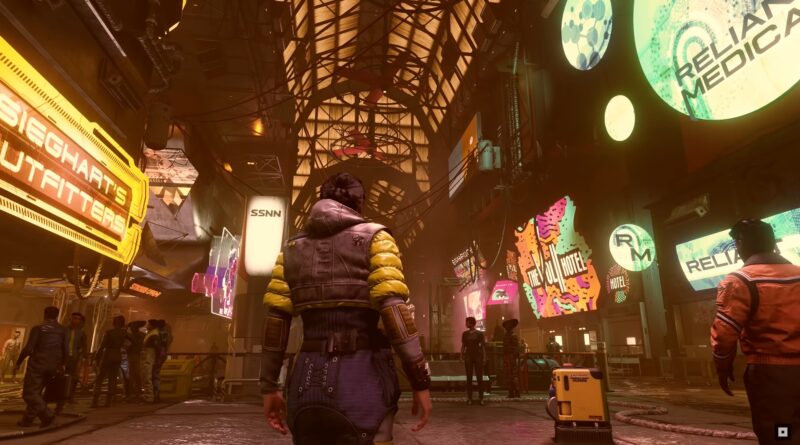Let’s examine the complete analysis and consider how the best and most overpowered Builds could work in Starfield. All weapons, Armor, Skills, and more!

Starfield is set in 2330, when humanity has reached beyond our solar system, expanding throughout the galaxy. This game will feature many features, nearly all of which will influence your character, build, and story aspects. Here’s what to expect.
How will the Starfield Builds work? – Complete Analysis






Creating builds in Starfield involves the analysis and a balance of choices you make from the character creation screen all the way to skills, weapon customization, companions, and even your Starship. The variables in builds current are weapons, armor, aid, throwables, skills, backgrounds, traits, companions, and Starborn powers. These aspects of builds will influence your power, story, and overall direction with the game. The main story is set to level 30 so you can expect about 30-50 hours to reach around that level.
Here’s a list of all the aspects of Builds in Starfield – Ingredients Analysis:
- Character Creator: Pick appearance, background, and trait that will influence your starting skills, dialog options, and quest outcomes.
- Level: Each level will give you a skill point with no max level cap.
- Skill trees: five trees in total Social, Tech, Physical, Science, and Combat. Each with 16 or more skills to select.
- Skill rank: Each individual skill you select, including your starting skill, will have ranks that can be increased.
- Traits: optional selections in character creator that come with pros and cons.
- Weapons: three different types physical | Energy | Electromagnetic, with over 40 weapons to choose from.
- Weapon Mods: Customize each gun or melee weapon up to 8 slots depending on the weapon type.
- Armor: including damage reduction and resistance to environmental effects and even airborne efficiency.
- Starborn Powers: introduced in the story you can unlock ultra-power abilities.
- Crew & Companions also have up to four skills aiding you inside combat.
- Throwables: These are Frag Grenades, Mines, and more generalized damage for one-time use.
- Aid: This is food or substances that give you a boost or remove negative status effects.
Character Creation

Moving to the analysis of Starfield’s character creator, it features a robust set of features to alter your appearance, starting skills, and optional traits you can use to create your dream builds. During character creation, you will see the image of your character and, alter the style of the body face and eventually move to the background, where it starts to get interesting!
Backgrounds

Backgrounds are your character’s “starting class.” You can choose your character’s origin story from 16 available in total. This setting will determine your three starting skills and how the game environment and NPC characters will react and interact with your character. As we know from previous Bethesda titles, what skills and which path you decide next is completely up to you and with no limitations, you have massive replayability.
Firstly, let’s work towards creating a stealth build-type character. The logical choice is, for example, Cyber Runner. From Neon to New Atlantis, the megacorps stand as monuments to power, prestige, and profit. You’ve worked both for and against them, on the inside and out, often sacrificing conscience for credits. Below is a list of the Cyber Runner’s skills unlocked at level 1:
- Stealth: Adds a Stealth Meter. You are 25% more difficult to detect when sneaking. Suppressed weapons do an additional 5% sneak attack damage.
- Security: You can attempt to hack Advanced locks, and 2 auto attempts can be banked.
- Theft: Unlock the ability to pickpocket targets.
These skills are given to you at level 1, and progress by using the skill or some other function. The Stealth skill you can level by sneaking (crouching) and doing stealth attacks similar to Skyrim with a bow. Security look for Digipick locks and complete that mechanic. Theft you will need to sneak then try to pickpock targets. When in doubt, read the skill on how to level it which most are quite easy.
Traits


Players can select up to three attributes from a wide list of Traits to further shape their characters. Each provides unique advantages and disadvantages, and thus traits are optional. However, some traits cannot be combined with others. For example, having Traits like “Introvert” can’t be combined with the “Extrovert” trait.
An example of a trait selection is Kid Stuff. Your character can visit their living parents, and 2% of all the money players earn will be deducted and sent to the parents. Now this adds a lot of variety and storytelling, but what about build-crafting and performance?
Let’s look at another example of a trait that might benefit our build template for a stealth player: Hero Worshipped. You’ve earned the attention of an annoying ‘Adoring Fan’ who will show up randomly and jabber at you incessantly. He’ll join your ship’s crew, give you gifts, and annoy you all the time.
But what’s interesting about this character is in the top left, upon confirming him as a part of your crew, you notice the three starting skills. One of which being concealment! This is a 4th tier physical skill which allows him to stay more easily concealed and produces many times the normal amount of damage while attacking from Stealth. Surprisingly, he could be the perfect companion in certain combat situations.
Traits will be more of a performance disadvantage and a roleplay element that adds flavor to your character. Playing with Wanted for instance spices up the game because you are regularly swarmed with bounty-hunting mercenaries. However, this can get annoying so be careful when selecting a trait. As the game unfolds, we will find new and unique ways to take advantage of backgrounds and traits, but so far, Cyber Runner and Adoring Fan could be a great start.
Leveling and Level Cap

Like any RPG, you earn levels by gaining experiences from various sources. Additionally, most of these mechanics are similar to Fallout and Skyrim series. For example, you need to kill enemies, explore the map, complete the quests, and do other standard activities. At each level, you receive one skill point to set. There is no level cap in Starfield, and it’s meant to be played for a long time. Keep in mind there is a also new game plus, and I’ve beaten the game in roughly 25 hours going straight through during early access. Many of you reading this might not be at that point so I won’t spoil the information for you, but New Game Plus gives you two incredibly helpful things.
Skills


In Starfield, each level gives you one skill point for your build. You can spend that skill point to unlock a skill or rank it up. Once you unlock a skill, you will have to complete challenges to rank it up. Boost Pack Training for instance requires you to use the boost pack while in combat. Crafting skills have you craft, and you can read the individual skill to see what you need to do next.
You will see the tree, which starts at the top and moves down. You need 4 or more skills to move to a new level in the tree, and can spend them however you want. What I found help was picking two skills in each skill tree and ranking them up to two to meet the level 4 requirements. Early levels your skill selection is weak and most of the time only two to three skills seem to add anything substantial. Don’t spread the skill points thin or put points in skills you have no intention of leveling. We have fully customized builds that give you examples 1-30, for instance.
Here is a list of the five skill trees in Starfield:
- Combat: focus primarily on weapons and weapon upgrades, increasing the overall damage of each weapon type. Additionally, this skill tree will improve your combat performance, accuracy, quickening, reload speed and ammo count.
- Social: help you interact with other NPC and persuade them or even manipulate them to your liking. These abilities can improve your trading and negotiation skills.
- Tech: focus on your ability to control and utilize advanced technology in combat, ships, outposts and exploration. It also allows players to pick more secure digital locks, hack consoles and terminals or extract any data.
- Physical: focus on improving character base stats such as health, stamina and endurance, increasing character survivability and damage reduction. It also increases character melee combat capabilities.
- Science: can improve character, medic, exploration abilities and technology. They also focus on crafting times, unlocking more recipes and research. Starfield Crafting includes weapons, armor and consumables.
Here is an example of skill progression from our Stealth Build Guide level 1-10:
- Level 1: Stealth, Security, and Theft
- Level 2: Boost Pack Training
- Level 3: Ballistics
- Level 4: Medicine
- Level 5: Astrodynamics
- Level 6: Fitness
- Level 7: Wellness
- Level 8: Stealth Rank 2
- Level 9: Medicine Rank 2
- Level 10: Astrodynamics Rank 2
Some skills are more difficult to get than others. For instance, the game hides two very important crafting skills in the Science tree, Weapon Engineering and Spacesuit Design. These two are essential to customize your weapons and armor, thus I recommend nearly every build at least unlock rank 1 or 2 by level 30. Another incredible skill buried is Isolation in the Social skill tree level two. This allows you to get the “lone wolf” perks playing without a companion like previous Bethesda games. Increase damage and reduce damage taken, which is perfect for a Bounty Hunter build.
Weapons
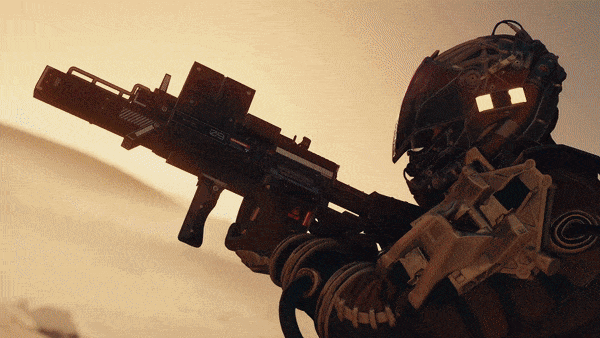

Weapon customization ties into the crafting system and requires resources from planets, research from a researching station and required skill unlocks typically from Science. Each weapon can have up to 8 mods available , with most having from between 5 and 7. Weapons appear to be three broad weapon categories: Physical, Energy, and Electromagnetic. From these three weapon types, you get your usual suspects when it comes to guns, shotguns, rifles, snipers, pistols, submachines, and some heavy mini gun action. The electromagnetic weapons or mag weapons look incredible and are sure to be something to experiment with.
Weapon crafting requires a lot of materials and skill points but highly recommend investing in the Science skill tree to get Weapon Design. The first step is to purchase or find a weapon, then a weapon crafting station. By default, you are giving a station at the Lodge basement in Constellation home of New Atlantis. I recommend getting an outpost and building there because you can have much more storage which you will need. Let’s take a look a weapon and a chart to show you how mods could work.

Here is an image from the Hard Target rifle with one mod and new weapon effects. From our Sniper build, we have a chart with recommended weapon modification to fit the build profile and performance:
| Hard Target Weapon Slot | Mod |
|---|---|
| Barrel | Stabilizing Barrel |
| Laser | Recon Laser Sight |
| Optic | Long Scope |
| Muzzle | Muzzle Brake |
| Grip & Stock | Tactical |
| Magazine and Battery | Armor-Piercing Ammunition |
| Internal | High Powered |
| Skin | – |
The priority in general with weapon modification is to mod the Barrel to level the skill line first. Your main source of damage comes from Magazine and Battery, along with Internal. Muzzle is great for stealth with Suppersors while laser and optics help with aiming. Some weapons have receivers which can adjust the rate of fire, like semi-automatic or fully automatic. Again, it’s imperative you level the skill line and invest early in Science otherwise you will hit level 30 with zero ability to mod weapons.
Sniping
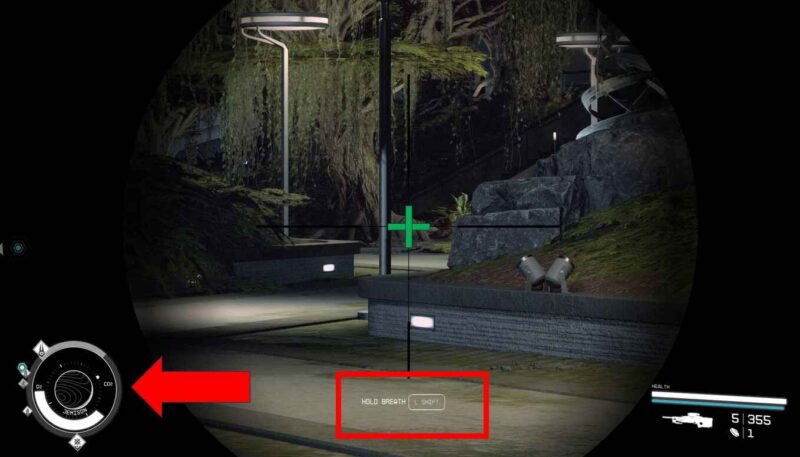
To perform a Sniper Shot in Starfield, simply hold down the aim and enter the cross-hair of the scope. You can then steady your aim and use your Oxygen as a resource. This is why it’s important for Snipers to have high Oxygen capacity for Sniping, and the longer you hold the button down, the more likely you are to build up CO2. Additional skills like Ballistics, Sharpshooting, and Marksman can add even more damage giving you that range one-shot killer build.
In Starfield, any gun can technically be a “sniper rifle.” The Sniper Certification skill gives a benefit for weapons with scopes. Obviously, you want a non-automatic Rifle, typically a ballistic weapon as your choice.
Stealth
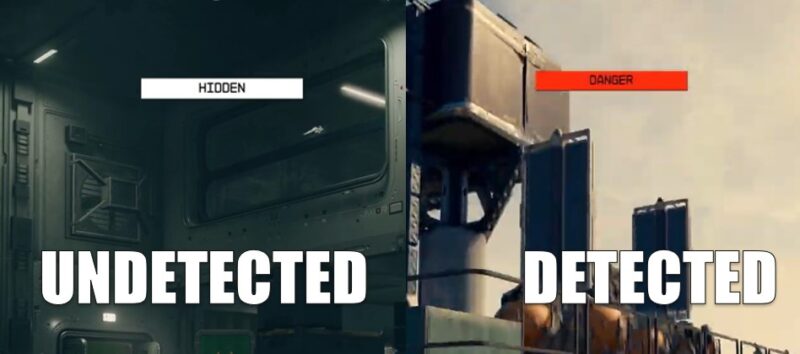
The stealth mechanic in Starfield works with a “hidden” bar on the top center of the screen. As you become detected or concealed, the bar moves back and forth. You can also get a sneak damage multiplier while stealth, including using silencers. This requires the skill Stealth from the Physical skill tree.
The idea behind stealth is to “crouch” outside of combat to enable the “HIDDEN” bar at the top of your screen. This will enable the Stealth and Concealment skills to activate and increase your damage. Then your goal is to move undetected without alerting enemies including melee or ranged damage while stealthed.
Armor



Also, armor comes in three pieces with a fourth additional apparel giving small bonuses. You can customize and modify your armor similar to weapons through the Spacesuit Design skill in the Science skill tree. You will need a spacesuit workbench and an early game you can get this at the Lodge in New Atlantis after meeting the Constellation group. Consequently, the biggest thing you want to focus on is getting the Boost Pack Training skill in the Tech skill tree. This makes a dramatic difference in your gameplay. As you advance, you can customize this boost and get an indefinite boost. Consider armor customization limited in comparison to weapons, but still worth investing in.

Armors are available in four distinct qualities: white, blue, purple, and the legendary yellow. Moreover, if an armor piece holds the rarity of blue or higher, it boasts an accompanying perk or trait. These augmentations introduce supplementary effects alongside any modifications. For instance, the “Beast Hunter” perk reduces damage from Alien enemies by 15%. While most of these enhancements are bestowed randomly, noteworthy exceptions include quest-related items that possess standardized attributes. Optimal resource utilization suggests reserving modifications for blue or higher quality armors, preventing the squandering of materials on non-perk gear that ultimately holds limited potency.
The Mantis Legendary armor has three armor effects:
- 02 Filter: -25% oxygen consumption
- Antisepctic: +25 Airborne Resistance
- Assisted Carry: Drain 75% less 02 when running while encumbered.
This piece of gear makes an amazing addition for folks crafting and constantly hauling resources back to their locations.
Crew & Companions
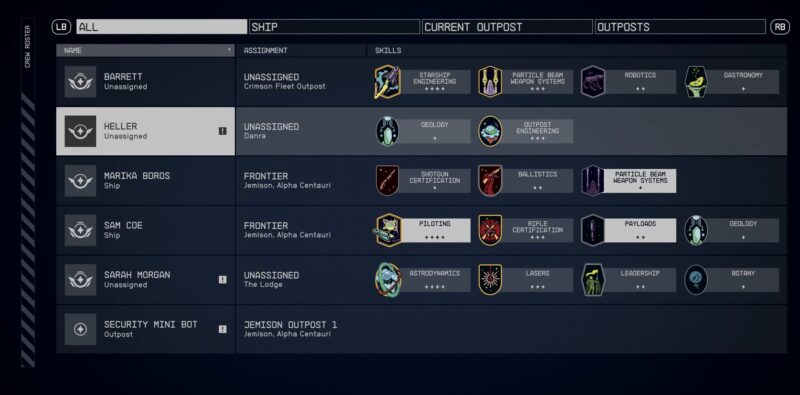
For companions, all you need to do is recruit them into your party and give them weapons and armor. As a result, you need to have them equip it, and even without ammunition, they will fire their weapons. I always give my companion a heavy weapon with super expensive ammunition or flashy animations because it’s satisfying watching them destroy everything. They also have a carrying capacity, so it’s equally as nice to bring them to a fight where they can help you with the loot you find afterward. You will also encounter “crew” which are a weaker version of companions with less backstory and skills. Companions include Barrett, Sarah Morgan, Andreja, and Vasco, the robotic companion.
Sam Coe is former space cowboy joins up with you on the main story quest and his skills are:
- Piloting (4 stars)
- Rifle Certification (3 stars)
- Payloads (2 stars)
- Geology (1 star)
You can also assign companions to the outpost and your ship or play entirely solo. The Social skill line Isolation gives you the lone wolf perks of playing solo with increased damage and damage reduction. Leadership in this same skill line will boost your companion’s power in addition to helping with carrying capacity. I found it ultimately easier to use companions because of the carrying capacity and also not to get lonely.
Looking for more about Starfield?
Thank you for reading The Starfield Builds – Complete Analysis! We’ll do more deep dives into Starfield and cover the game. Additionally, you can also watch Deltia streaming the game on Twitch.
 Reddit
Reddit
 Email
Email


